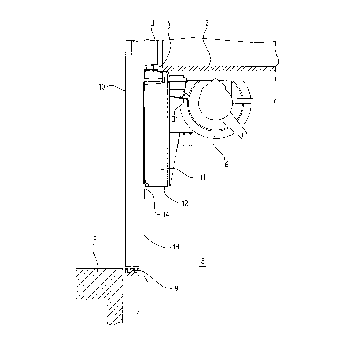Some of the information on this Web page has been provided by external sources. The Government of Canada is not responsible for the accuracy, reliability or currency of the information supplied by external sources. Users wishing to rely upon this information should consult directly with the source of the information. Content provided by external sources is not subject to official languages, privacy and accessibility requirements.
Any discrepancies in the text and image of the Claims and Abstract are due to differing posting times. Text of the Claims and Abstract are posted:
| (12) Patent Application: | (11) CA 2234333 |
|---|---|
| (54) English Title: | LIFT WITH CONTROL BOX |
| (54) French Title: | ASCENSEUR AVEC BOITE DE COMMANDE |
| Status: | Deemed Abandoned and Beyond the Period of Reinstatement - Pending Response to Notice of Disregarded Communication |
| (51) International Patent Classification (IPC): |
|
|---|---|
| (72) Inventors : |
|
| (73) Owners : |
|
| (71) Applicants : |
|
| (74) Agent: | RICHES, MCKENZIE & HERBERT LLP |
| (74) Associate agent: | |
| (45) Issued: | |
| (22) Filed Date: | 1998-04-08 |
| (41) Open to Public Inspection: | 1998-10-11 |
| Availability of licence: | N/A |
| Dedicated to the Public: | N/A |
| (25) Language of filing: | English |
| Patent Cooperation Treaty (PCT): | No |
|---|
| (30) Application Priority Data: | ||||||
|---|---|---|---|---|---|---|
|
Lift with drive system which is mounted at the cage and the control box (11) of which is
arranged above or below the cage door (3). Through the invention it is made possible for
the service engineer to reach the electrical components of the lift, such as travel
regulation, safety circuits, optional drive regulation, frequency inverter, etc., conveniently
standing at hand or eye level at a storey floor (5) with the shaft doors (10) opened.
Ascenseur avec système de commande monté sur la cabine et dont la boîte de commande (11) est placée au-dessus ou au-dessous de la porte de la cabine (3). Grâce à l'invention, le technicien qui fait la maintenance a facilement accès aux composantes électriques de l'ascenseur, notamment les limiteurs de fin de course, circuits de sécurité, dispositifs de commande optionnels, inverseur de fréquence et autres, lesquelles se trouvent commodément situées à hauteur de la main ou des yeux sur un palier d'étage (5) quand les portes de la gaine (10) sont ouvertes.
Note: Claims are shown in the official language in which they were submitted.
Note: Descriptions are shown in the official language in which they were submitted.

2024-08-01:As part of the Next Generation Patents (NGP) transition, the Canadian Patents Database (CPD) now contains a more detailed Event History, which replicates the Event Log of our new back-office solution.
Please note that "Inactive:" events refers to events no longer in use in our new back-office solution.
For a clearer understanding of the status of the application/patent presented on this page, the site Disclaimer , as well as the definitions for Patent , Event History , Maintenance Fee and Payment History should be consulted.
| Description | Date |
|---|---|
| Inactive: IPC from MCD | 2006-03-12 |
| Inactive: IPC from MCD | 2006-03-12 |
| Time Limit for Reversal Expired | 2004-04-08 |
| Application Not Reinstated by Deadline | 2004-04-08 |
| Deemed Abandoned - Failure to Respond to Maintenance Fee Notice | 2003-04-08 |
| Inactive: Abandon-RFE+Late fee unpaid-Correspondence sent | 2003-04-08 |
| Application Published (Open to Public Inspection) | 1998-10-11 |
| Inactive: First IPC assigned | 1998-08-06 |
| Inactive: IPC assigned | 1998-08-06 |
| Classification Modified | 1998-08-06 |
| Inactive: Filing certificate - No RFE (English) | 1998-06-17 |
| Application Received - Regular National | 1998-06-16 |
| Abandonment Date | Reason | Reinstatement Date |
|---|---|---|
| 2003-04-08 |
The last payment was received on 2002-03-27
Note : If the full payment has not been received on or before the date indicated, a further fee may be required which may be one of the following
Patent fees are adjusted on the 1st of January every year. The amounts above are the current amounts if received by December 31 of the current year.
Please refer to the CIPO
Patent Fees
web page to see all current fee amounts.
| Fee Type | Anniversary Year | Due Date | Paid Date |
|---|---|---|---|
| Registration of a document | 1998-04-08 | ||
| Application fee - standard | 1998-04-08 | ||
| MF (application, 2nd anniv.) - standard | 02 | 2000-04-10 | 2000-03-27 |
| MF (application, 3rd anniv.) - standard | 03 | 2001-04-09 | 2001-03-22 |
| MF (application, 4th anniv.) - standard | 04 | 2002-04-08 | 2002-03-27 |
Note: Records showing the ownership history in alphabetical order.
| Current Owners on Record |
|---|
| INVENTIO AG |
| Past Owners on Record |
|---|
| CHRISTOPH LIEBETRAU |
| KASPAR SCHINDLER |
| UTZ RICHTER |